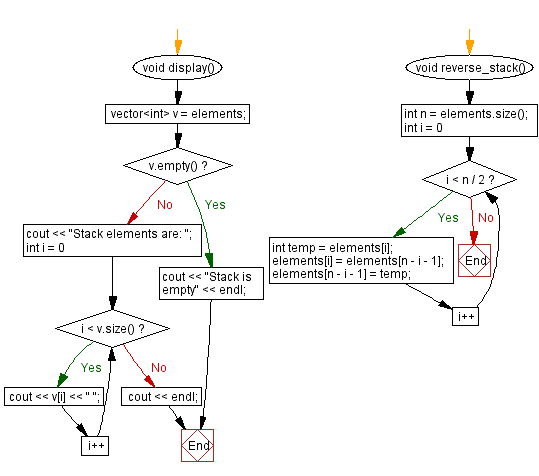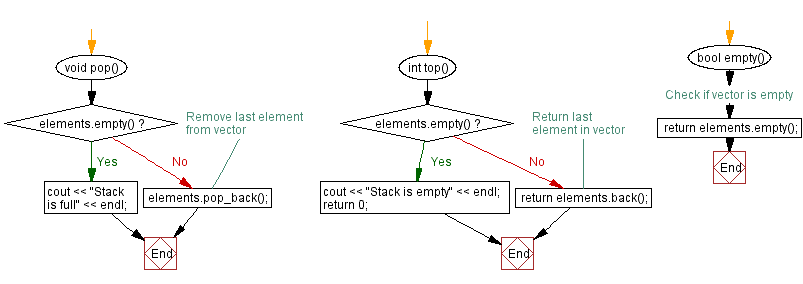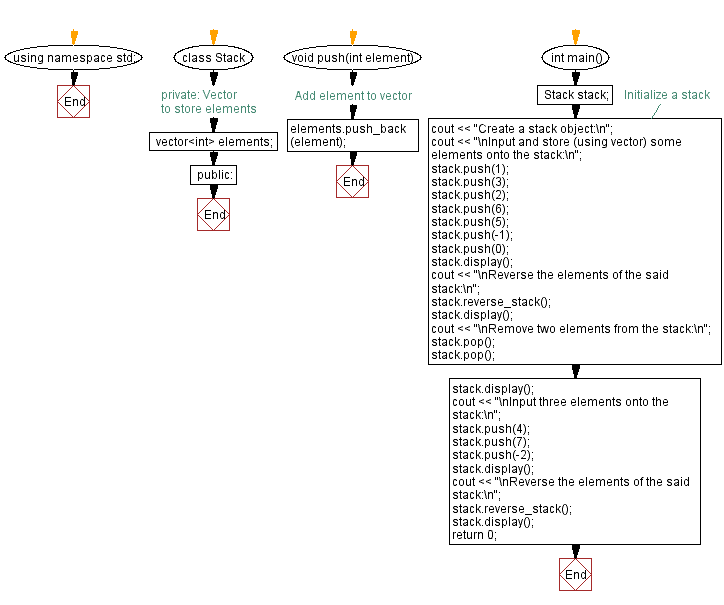C++ Stack Exercises: Reverse a stack (using a vector) elements
26. Reverse the Elements of a Vector-Based Stack
Write a C++ program that reverses the stack (using a vector) elements.
Test Data:
Create a stack object:
Input and store (using vector) some elements onto the stack:
Stack elements are: 1 3 2 6 5 -1 0
Reverse the elements of the said stack:
Stack elements are: 0 -1 5 6 2 3 1
Sample Solution:
C++ Code:
#include <iostream>
#include <vector>
#include<algorithm>
using namespace std;
class Stack {
private:
vector<int> elements; // Vector to store elements
public:
void push(int element) {
elements.push_back(element); // Add element to the end of the vector
}
void pop() {
if (elements.empty()) {
cout << "Stack is full" << endl; // Display full message if the stack is empty
} else {
elements.pop_back(); // Remove the last element from the vector
}
}
int top() {
if (elements.empty()) {
cout << "Stack is empty" << endl; // Display empty message if the stack is empty
return 0;
} else {
return elements.back(); // Return the last element in the vector
}
}
bool empty() {
return elements.empty(); // Check if the vector is empty
}
void display() {
vector<int> v = elements;
if (v.empty()) {
cout << "Stack is empty" << endl; // Display empty message if the stack is empty
return;
}
cout << "Stack elements are: ";
for (int i = 0; i < v.size(); i++) {
cout << v[i] << " "; // Display the elements of the stack
}
cout << endl;
}
// Function to reverse the elements of the stack
void reverse_stack() {
int n = elements.size();
for (int i = 0; i < n / 2; i++) {
int temp = elements[i];
elements[i] = elements[n - i - 1];
elements[n - i - 1] = temp;
}
}
};
int main() {
Stack stack;
cout << "Create a stack object:\n"; // Initialize a stack
cout << "\nInput and store (using vector) some elements onto the stack:\n";
stack.push(1);
stack.push(3);
stack.push(2);
stack.push(6);
stack.push(5);
stack.push(-1);
stack.push(0);
stack.display();
cout << "\nReverse the elements of the said stack:\n";
stack.reverse_stack();
stack.display();
cout << "\nRemove two elements from the stack:\n";
stack.pop();
stack.pop();
stack.display();
cout << "\nInput three elements onto the stack:\n";
stack.push(4);
stack.push(7);
stack.push(-2);
stack.display();
cout << "\nReverse the elements of the said stack:\n";
stack.reverse_stack();
stack.display();
return 0;
}
Sample Output:
Create a stack object: Input and store (using vector) some elements onto the stack: Stack elements are: 1 3 2 6 5 -1 0 Reverse the elements of the said stack: Stack elements are: 0 -1 5 6 2 3 1 Remove two elements from the stack: Stack elements are: 0 -1 5 6 2 Input three elements onto the stack: Stack elements are: 0 -1 5 6 2 4 7 -2 Reverse the elements of the said stack: Stack elements are: -2 7 4 2 6 5 -1 0
Flowchart:



For more Practice: Solve these Related Problems:
- Write a C++ program to reverse a vector-based stack and print the reversed sequence without using reverse iterators.
- Develop a C++ program that creates a stack using vectors and then displays the elements in reverse order.
- Design a C++ program to implement a vector-based stack and reverse its contents by swapping elements from both ends.
- Implement a C++ program to build a stack using vectors and output the reversed order using a manual loop.
Go to:
PREV : Sort the Elements of a Vector-Based Stack.
NEXT : Find the Middle Element(s) of a Vector-Based Stack.
CPP Code Editor:
Contribute your code and comments through Disqus.
What is the difficulty level of this exercise?
